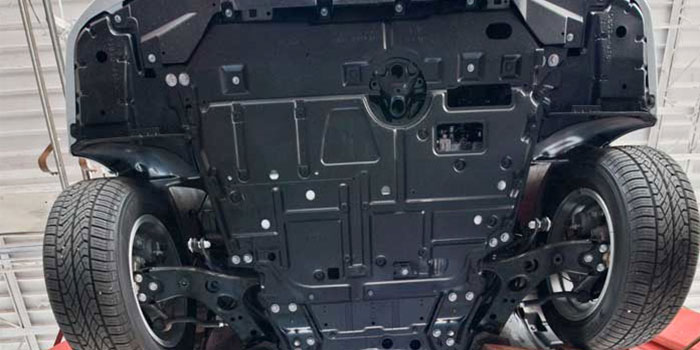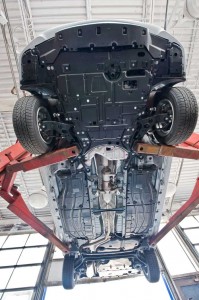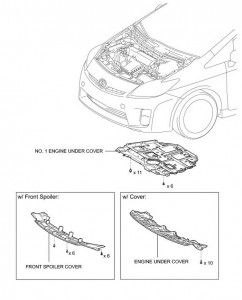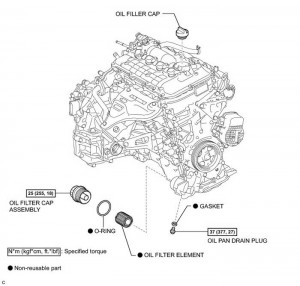Does the thought of changing the oil on a Toyota Prius scare you? Are you afraid you could be shocked with more than 200 volts? Don’t be afraid, changing the oil is not radically different than any other Toyota.
Changing the engine oil on just about every hybrid doesn’t require disconnecting the hybrid drive system, but be sure to follow the manufacturer’s recommendation for powering down the vehicle. The Prius doesn’t require any special procedures except making sure the system is off.
Hybrids make different demands on oil than non-hybrid vehicles. Depending on the state of the battery, the engine will turn off at a stop and not activate until the vehicle is rolling or under hard acceleration. This increases the frequency of starts where the engine will go from zero oil pressure to normal operating pressures, which is when most wear occurs.
Engine Oil
Always use high-quality oil for a Prius — not using the correct weight will damage the top-end of the motor. The proper weight of the oil is typically written on the oil filler cap.
Early Prius models require a GF-4 or equivalent oil. GF-5 and GF-6 oils are back compatible. Some 2006 to current models call for 0W-20 motor oil and earlier models call for 5W-20 oil.
Toyota has written a piece of code into the ECM that correlates oil pressure and temperature with crankshaft speed. This can, in theory, detect oil grades that are not right for the vehicle. If the system detects oil pressure that is too high or low, it will reduce power and/or shut down the engine. It will also set code P3191 for a nonrunning engine.
Be careful using a bulk oil dispenser. The baffle located inside the valve cover can bend if you let the weight of the bulk oil dispenser rest on the baffling. If the baffling is bent, oil sludging may occur.
Oil Capacities
2000-’09 – 3.9 quarts (with filter)
2010-’13 – 4.4 quarts (with filter)
Under Tray
The first-generation Prius does not have an under tray to remove in order to access the filter and drain plug. The second-generation Prius models, starting around 2009, have an under tray with an access door. You just have to remove a few fasteners and pull down or fold the access door to get at the oil filter and drain plug. The panel does not need to be completely removed.
Drain Plug
The drain plug on all models uses a nylon washer gasket that should be replaced every oil change. The torque specification for the drain plug is usually 27 ft.-lbs. for all Toyota models.
Filter
The 2000-’09 Toyota Prius uses a screw-on oil filter; the 2010-’13 1.8L engine uses a cartridge-style filter. The screw-on filter has a torque specification of 28 ft.-lbs. and the cartridge-style has a torque specification of 18 ft.-lbs. To remove, use a 65mm filter wrench. Damaging the housing can cost you $50 or more for a replacement.
Maintenance Light Reset
Most Prius models are equipped with an oil change maintenance light that has to be reset after an oil change.
Non-Navigation Models:
1. Turn the power switch to OFF mode with the trip meter “A” showing.
2. Turn the power switch to ON mode with the mph or km/h button held down.
3. Hold the button down until the odometer indicates “000000” and the multi-information display indicates that the reset is complete.
Navigation Maintenance Item Setting (if equipped):
When the navigation system is turned on, the “Information” screen displays when it is time to replace a part or certain components.
1. Push the “Setup” button.
2. Touch “Vehicle.”
3. Touch “Maintenance.”
4. Follow the onscreen prompts.
5. Touch “OK,” and the screen returns to the “Maintenance” screen.
Topping Off The Prius
Transmission
On the Prius, the CVT part of the transmission is sandwiched between the two motor/generators. In the first-generation Prius, there were rare reports of the transmission fluid leaking into the electric motor case and damaging the insulation. Any leak or loss of fluid should be taken seriously. Prius models with the CVT transmission will require a CVT-specific transmission fluid, while others will require a specific grade of fluid that could be compatible with conventional transmission fluid specifications.
Coolant
The Prius has a separate cooling system for the inverter and electric motors/generators in the transmission case. The system has its own electric pump and radiator. Always make sure the fluid is at the correct level. Most manufacturers recommend flushing and filling the system when the engine’s cooling system is serviced.
Power Steering
The Prius has electric power steering.
Brake Fluid
Toyota recommends DOT 3 brake fluid. DOT 4 and DOT 5.1 fluids are compatible with the system.

















